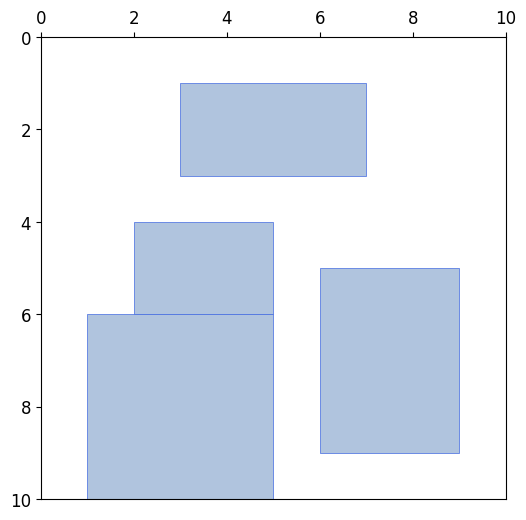배치와 연결 (1) - 빈 공간 찾아서 상자 배치하기¶
위 그림과 같은 너비 10, 높이 10의 평면에 세 개의 파란색 상자가 놓여져 있습니다.
이 평면에 특정한 너비와 높이를 갖는 새로운 상자를 놓을 위치를 찾는 방법을 소개합니다.
■ Table of Contents
1) 평면 공간 만들기¶
import numpy as np
import matplotlib.pyplot as plt
import matplotlib.patches as patches
width, height = 10, 10
canvas1 = np.zeros((height, width))
rect_info = [(2, 4, 3, 2), (3, 1, 4, 2), (6, 5, 3, 4)]
print('Before Placement:')
print(canvas1)
Before Placement:
[[0. 0. 0. 0. 0. 0. 0. 0. 0. 0.]
[0. 0. 0. 0. 0. 0. 0. 0. 0. 0.]
[0. 0. 0. 0. 0. 0. 0. 0. 0. 0.]
[0. 0. 0. 0. 0. 0. 0. 0. 0. 0.]
[0. 0. 0. 0. 0. 0. 0. 0. 0. 0.]
[0. 0. 0. 0. 0. 0. 0. 0. 0. 0.]
[0. 0. 0. 0. 0. 0. 0. 0. 0. 0.]
[0. 0. 0. 0. 0. 0. 0. 0. 0. 0.]
[0. 0. 0. 0. 0. 0. 0. 0. 0. 0.]
[0. 0. 0. 0. 0. 0. 0. 0. 0. 0.]]
np.zeros() 함수를 사용해서 너비 (width)/높이 (height)가 10이고 모두 0을 갖는 NumPy 어레이 canvas1을 만들었습니다.
rect_info는 이 평면에 놓여질 사각형 상자 정보 ((x, y, w, h))의 리스트입니다.
2) 상자 배치하기¶
def draw_rect(canvas, rectangles):
for i, (x, y, w, h) in enumerate(rectangles):
canvas[y:y+h, x:x+w] = i + 1
draw_rect(canvas1, rect_info)
print('After Placement:')
print(canvas1)
print(rect_info)
After Placement:
[[0. 0. 0. 0. 0. 0. 0. 0. 0. 0.]
[0. 0. 0. 2. 2. 2. 2. 0. 0. 0.]
[0. 0. 0. 2. 2. 2. 2. 0. 0. 0.]
[0. 0. 0. 0. 0. 0. 0. 0. 0. 0.]
[0. 0. 1. 1. 1. 0. 0. 0. 0. 0.]
[0. 0. 1. 1. 1. 0. 3. 3. 3. 0.]
[0. 0. 0. 0. 0. 0. 3. 3. 3. 0.]
[0. 0. 0. 0. 0. 0. 3. 3. 3. 0.]
[0. 0. 0. 0. 0. 0. 3. 3. 3. 0.]
[0. 0. 0. 0. 0. 0. 0. 0. 0. 0.]]
[(2, 4, 3, 2), (3, 1, 4, 2), (6, 5, 3, 4)]
drawRect()는 2차원 어레이 (canvas)와 사각형 상자 정보를 입력받아서 배치하는 함수입니다.
세로 방향을 높이로, 가로 방향을 너비로 표시되도록 했습니다.
3) 새 상자 놓을 위치 찾기¶
new_rect = [0, 0, 4, 4]
def find_place(canvas, rectangle):
w_rect, h_rect = rectangle[2], rectangle[3]
options = []
for i in range(height - h_rect + 1):
for j in range(width - w_rect + 1):
if not np.any(canvas[i:i+h_rect, j:j+w_rect]):
options.append((j, i))
rand = np.random.randint(len(options))
return options[rand]
new_x, new_y = find_place(canvas1, new_rect)
new_rect[0:2] = new_x, new_y
rect_info.append(tuple(new_rect))
print(rect_info)
[(2, 4, 3, 2), (3, 1, 4, 2), (6, 5, 3, 4), (1, 6, 4, 4)]
new_rect는 새롭게 놓을 상자의 정보입니다. 너비 높이가 4이고, x, y 위치는 우선 0으로 지정했습니다.
find_place()함수는 평면 공간에서 새로운 상자를 놓을 수 있는 위치의 후보를 찾아서 그 중 하나의 위치를 반환합니다.
not np.any(canvas[i:i+h_rect, j:j+w_rect])는 평면 공간 i, j의 위치에서 새로운 상자의 너비와 높이만큼의 공간이 비어있는지 확인합니다.
options는 새로운 상자를 놓을 수 있는 위치들의 후보를 갖는 리스트입니다.
np.random.randint() 함수를 사용해서 임의의 성분을 반환하도록 하고,
rect_info 리스트에 새로운 상자의 정보를 튜플의 형태로 변환해서 추가합니다.
4) 새 상자 배치하기¶
draw_rect(canvas1, rect_info)
print('After New Placement:')
print(canvas1)
print(rect_info)
After New Placement:
[[0. 0. 0. 0. 0. 0. 0. 0. 0. 0.]
[0. 0. 0. 2. 2. 2. 2. 0. 0. 0.]
[0. 0. 0. 2. 2. 2. 2. 0. 0. 0.]
[0. 0. 0. 0. 0. 0. 0. 0. 0. 0.]
[0. 0. 1. 1. 1. 0. 0. 0. 0. 0.]
[0. 0. 1. 1. 1. 0. 3. 3. 3. 0.]
[0. 0. 4. 4. 4. 4. 3. 3. 3. 0.]
[0. 0. 4. 4. 4. 4. 3. 3. 3. 0.]
[0. 0. 4. 4. 4. 4. 3. 3. 3. 0.]
[0. 0. 4. 4. 4. 4. 0. 0. 0. 0.]]
[(2, 4, 3, 2), (3, 1, 4, 2), (6, 5, 3, 4), (1, 6, 4, 4)]
새 상자를 포함해서 다시 평면에 상자를 배치했습니다.
네번째 상자가 빈 공간에 배치된 것을 볼 수 있습니다.
5) Matplotlib 시각화하기¶
plt.style.use('default')
plt.rcParams['figure.figsize'] = (6, 6)
plt.rcParams['font.size'] = 12
fig, ax = plt.subplots()
for (x, y, w, h) in rect_info:
ax.add_patch(
patches.Rectangle(
(x, y), w, h,
edgecolor='royalblue',
facecolor='lightsteelblue',
linewidth=0.5,
fill=True))
ax.axis((0, 10, 10, 0))
ax.xaxis.tick_top()
plt.show()
위 코드는 네 개의 상자들의 정보를 갖는 리스트 rect_info를 Matplotlib를 사용해서 시각화합니다.
Matplotlib patches 모듈을 사용해서 도형 시각화하기 페이지를 참고하세요.
axis()를 사용해서 축의 범위를 지정하고, tick_top()으로 X축 눈금을 상단에 위치하도록 했습니다.
결과는 아래와 같습니다.
전체 코드는 아래와 같습니다.
import numpy as np
import matplotlib.pyplot as plt
import matplotlib.patches as patches
width, height = 10, 10
canvas1 = np.zeros((height, width))
rect_info = [(2, 4, 3, 2), (3, 1, 4, 2), (6, 5, 3, 4)]
print('Before Placement:')
print(canvas1)
def draw_rect(canvas, rectangles):
for i, (x, y, w, h) in enumerate(rectangles):
canvas[y:y+h, x:x+w] = i + 1
draw_rect(canvas1, rect_info)
print('After Placement:')
print(canvas1)
print(rect_info)
new_rect = [0, 0, 4, 4]
def find_place(canvas, rectangle):
w_rect, h_rect = rectangle[2], rectangle[3]
options = []
for i in range(height - h_rect + 1):
for j in range(width - w_rect + 1):
if not np.any(canvas[i:i+h_rect, j:j+w_rect]):
options.append((j, i))
rand = np.random.randint(len(options))
return options[rand]
new_x, new_y = find_place(canvas1, new_rect)
new_rect[0:2] = new_x, new_y
rect_info.append(tuple(new_rect))
# print(rect_info)
draw_rect(canvas1, rect_info)
print('After New Placement:')
print(canvas1)
print(rect_info)
plt.style.use('default')
plt.rcParams['figure.figsize'] = (6, 6)
plt.rcParams['font.size'] = 12
fig, ax = plt.subplots()
for (x, y, w, h) in rect_info:
ax.add_patch(
patches.Rectangle(
(x, y), w, h,
edgecolor='royalblue',
facecolor='lightsteelblue',
linewidth=0.5,
fill=True))
ax.axis((0, 10, 10, 0))
ax.xaxis.tick_top()
plt.show()

